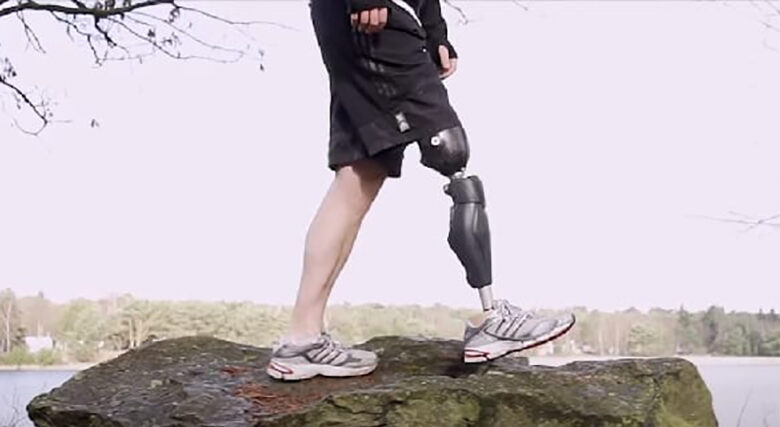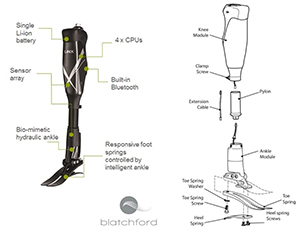
A complete guide to bionic legs and feet
Bionics For Everyone raises awareness of the latest bionic technologies available to people who have become amputees or have lost neurological capabilities. In the second complete guide it is sharing with our readers, it tells you everything you need to know about bionic legs, knees, ankles, and feet.
Visit our other article from Bionics for Everyone on bionic arms and hands.
Update 2024: Latest News for How Bionics Can Help People with Disabilities
Bionic technology continues to evolve rapidly, offering new hope and improved quality of life for people with disabilities. Recent advancements have focused on enhancing sensory feedback, neural control, and the integration of artificial intelligence, making bionic devices more intuitive and functional than ever before.
Sensory Feedback and Neural Control:
One of the most significant breakthroughs in bionic limbs is the development of advanced sensory feedback systems. These systems now provide users with a sense of touch and proprioception, allowing them to feel the position and movement of their prosthetic limbs. This enhancement significantly improves the user experience and functionality of bionic devices. Additionally, the Agonist-Antagonist Myoneural Interface (AMI), a novel surgical technique, has been developed to reconnect muscles in the residual limb. This innovation enables full neural control of bionic limbs, resulting in more natural movement and a better sense of embodiment for users.
AI-Powered Prosthetics:
The integration of artificial intelligence and machine learning into bionic devices represents another leap forward. Companies like Atom Limbs are at the forefront of this technology, developing prosthetics that can interpret electrical signals from the brain to control movement. These AI-powered limbs offer a full range of human motion and provide haptic feedback to the user, making them more intuitive and responsive than previous generations of prosthetics.
Accessibility and Cost Considerations:
While technological advancements continue, the cost of bionic devices remains a significant concern. Advanced prosthetics with high functionality can cost over €70,000, while more basic models start around €4,000. However, efforts are ongoing to make these technologies more affordable and accessible. Many prosthetic devices are covered by insurance, and various financial aid options and non-profit organizations are available to help those without insurance afford these life-changing devices.
Challenges and Future Directions:
Despite these advancements, challenges remain. A significant percentage of upper-limb amputees still abandon their prostheses due to issues like discomfort and limited functionality. Researchers are actively working to address these challenges by developing lighter, more comfortable, and functionally superior devices. There is also a growing focus on long-term studies to assess the safety and functionality of implantable electrodes and other advanced technologies in bionic limbs.
What is a bionic leg?
A bionic leg is an electromechanical device that attaches to the human body and replicates the functionality of a natural leg.
It always consists of sensors, a microprocessor ankle, a foot component, and at least one battery. Depending on the level of amputation, it may also include a microprocessor knee.
For example, here are a pair of diagrams for Blatchford’s Linx bionic leg, which has all of these components.

Understanding the technical challenges for bionic legs
The basic mechanics of walking
When humans walk, each leg alternates between a Stance phase (the foot has contact with the ground) and a Swing phase (the foot is off the ground). These phases can be divided into sub-phases:

Source: https://www.researchgate.net/figure/Human-gait-cycle-28_fig1_324346331
During this gait cycle, the body employs a number of biomechanical functions including:
- shock absorption by muscles, tendons, ligaments, and cartilage from the moment of heel strike until the full body weight is assumed by the stance leg;
- antagonistic muscle pairs to move the foot, ankle, knee, and hip into desired positions;
- the use of elastic energy as tendons and muscles stretch during the first half of the Stance phase, then recoil to help begin the swing phase;
- muscle contraction to lift each leg and propel the body forward;
Most of these functions have mechanical equivalents such as dampers, springs, actuators, etc. The challenge is controlling and coordinating them in a smooth, integrated manner.
Bionic leg control systems

When we humans approach an obstacle like stairs, we glance at them to gauge their height, steepness, tread width, etc. To climb the stairs with natural legs, we automatically adjust our stride, foot placement, joint angles, and muscle power. This is possible because of our brain’s ability to:
- perceive and create a 3D map of its surroundings including the terrain;
- use sensory feedback to maintain a keen sense of the body’s position within that 3D map;
- precisely adjust and control the movements of hundreds of muscles;
The bionic legs and feet currently on the market do not attempt to replicate this sophisticated system. Instead, they use sensors to detect things like walking speed, joint angles, etc. Microprocessors then use this data to automatically adjust things like joint resistance, sometimes hundreds of times per second.
These systems are localized, reactive, and completely independent from the human brain. Yet, they have proven to be remarkably successful, as shown in this short video of a double amputee walking and running up a set of stairs:
Now, users want more. They want more direct control over their bionic limbs, sensory feedback, and even power-assisted propulsion.
To learn where we are with these objectives, please see our full article on control systems for bionic legs and feet.
Current bionic ankles/feet
Bionic ankles/feet are responsible for the following tasks:
- automatically adjusting the resistance in the ankle to ensure the proper level of support through each stage of the stance phase regardless of terrain;
- keeping the foot “toes” up during the swing phase to create more clearance and reduce the risk of tripping;
- some bionic ankles also actively manage the ankle rotation (i.e. foot angle) based on terrain, and one (the Empower ankle) provides added propulsive power.
The main bionic ankles/feet currently on the market are:
- Empower from Ottobock
- Kinnex from Freedom Innovations
- Elan from Blatchford
- Elan IC from Blatchford
- Proprio from Ossur
- Meridium from Ottobock
- Raize from Fillauer
Unfortunately, it is difficult to find independent, first-hand consumer reviews of bionic ankles/feet. Most material on the subject is still either promotional or scientific.
Until that situation changes, we’ll settle for showing the latest advances such as this bionic ankle/foot for more active amputees:
Cost of bionic ankles/feet
Based mainly on user feedback, most bionic ankles/feet sell for between £18,000 to £25,000. This makes sense given that the Medicare/Medicaid reimbursement rates are around £18,000 for this type of device.
The most expensive bionic ankle/foot is Ottobock’s Empower Ankle, which sells for between £40,000 to £50,000. That’s quite a leap in price but if you watch our videos on the Empower, it’s also quite a leap in technology.
For more information, see our bionic foot price list.
Current bionic knees
Bionic knees are responsible for the following tasks:
- automatically adjusting the resistance in the knee to ensure the proper level of support through each stage of the stance phase regardless of terrain;
- ensuring the optimal release point for the knee to begin the swing phase and also the proper foot clearance during this phase, especially when ascending stairs, ramps, etc.;
- assisting in stumble recovery;
The main bionic knees currently on the market are:
- Kenevo from Ottobock
- C-Leg from Ottobock
- Genium from Ottobock
- Genium X3 from Ottobock
- Rheo from Ossur
- Rheo XC from Ossur
- Power Knee from Ossur
- Allux from Nabtesco/Proteor
- Plie from Freedom Innovations
- Orion from Blatchford
Again, it is difficult to find independent, first-hand consumer reviews of bionic knees. But this video of a young man using one of the most advanced knees — Ottobock’s Genium X3 — at least provides a glimpse of their potential:
Paired with the correct prosthetic foot, there are obviously few limits on the use of this knee. So, with a knee like this, why would someone need a bionic ankle? First, using the knee alone is more tiring without the assistance of a bionic ankle. It also isn’t as smooth when walking up or downstairs or other inclines.
This of course leads to the question: what happens when you combine these two technologies? We answer this question in the next main section.
Cost of bionic knees
Based mainly on user feedback, most bionic knees sell for between £25,000 to £50,000.
The most expensive bionic knee is Ottobock’s Genium X3, which can cost more than £100,000 depending on the prosthetic foot that is paired with it, warranty extensions, etc.
For more information, see our bionic knee price list.
Current full bionic legs
There is only one bionic leg we know about that fully integrates a bionic knee and ankle. This is Blatchford’s Linx:
It is inspiring to see amputees being so physically active. It’s proof that, technically, we are getting close to eliminating lower-limb disabilities.
The problem is one of availability. This is limited not only by price but also by insurance policies.
For example, Ossur combined its Rheo bionic knee with its Proprio bionic ankle to create a Symbionic leg product but the resulting product had poor sales. Why? Because public and private medical insurance resisted paying for it.
Cost of bionic legs
The Linx sells for between £60,000 and £70,000 including the socket and all prosthetist fees.
Open-Source bionic legs and feet
For decades now, the open-source approach has flourished in the software industry. It works by allowing the entire user community to contribute to software solutions. It speeds up innovation, reduces costs, and fosters standardization. Just on the issue of standardisation alone, this makes software more modular and easier to reuse.
Now compare this to the world of bionic legs and feet. Even though the tasks faced by one bionic limb manufacturer are quite similar to those faced by another, many take a proprietary approach. This has the unfortunate effect of slowing progress and making end products more expensive.
Fortunately, the University of Michigan is spearheading an Open-Source Bionic Leg initiative.
The objectives for this program are not yet as far-reaching as a typical open software initiative, as it is focused more on standardizing aspects of the R & D process. But the benefits of this approach will ultimately trickle down into the commercial market.
By Bionics For Everyone
Further Reading
- “Toward higher-performance bionic limbs for wider clinical use” (Nature Biomedical Engineering)
This scientific review discusses recent advancements in bionic limb technology, including osseointegration, neural interfaces, and sensory feedback. It provides an in-depth look at the current state of the field and future directions for improving prosthetic function and adoption. - Atom Limbs website
Atom Limbs is a company developing advanced bionic arms using AI and machine learning. Their website showcases their technology and vision for creating prosthetic limbs with near-full human range of motion, basic sense of touch, and mind-control capabilities. - Ottobock Prosthetic Legs Overview
This page from prosthetics manufacturer Ottobock provides an overview of their lower limb prosthetic solutions. It covers different types of prosthetic legs available, from basic models to advanced microprocessor-controlled knees. - “Prosthetic FAQs for the New Amputee” (Amputee Coalition)
This resource from the Amputee Coalition answers common questions new amputees may have about prosthetics. It covers topics like prosthesis costs, insurance coverage, the fitting process, and what to expect when using a prosthetic device. -
Neuromusculoskeletal Arm Prostheses: Personal and Social Implications of Living With an Intimately Integrated Bionic Arm” (Frontiers in Neurorobotics)This research article explores the experiences of individuals using advanced neuromusculoskeletal prosthetic arms in their daily lives. It provides insights into the personal and social impacts of these intimately integrated bionic limbs.
These resources offer a comprehensive overview of current prosthetic technologies, from cutting-edge research to practical information for users, covering both upper and lower limb prosthetics.
More on Disability Horizons…